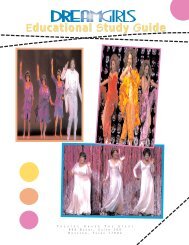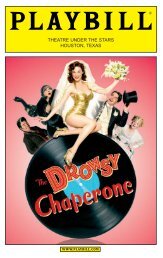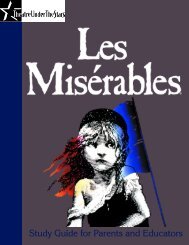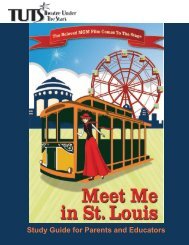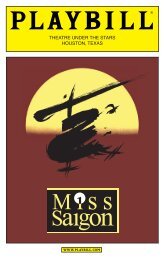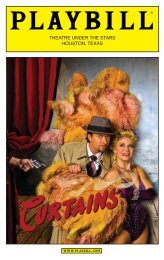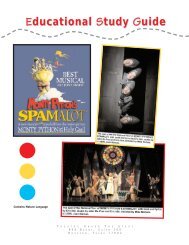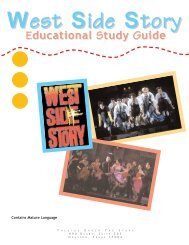The Drowsy Chaperone Study Guide - Theatre Under The Stars
The Drowsy Chaperone Study Guide - Theatre Under The Stars
The Drowsy Chaperone Study Guide - Theatre Under The Stars
Create successful ePaper yourself
Turn your PDF publications into a flip-book with our unique Google optimized e-Paper software.
<strong>The</strong> 1920s were the golden age of American<br />
musical theatre. Musical theatre composers<br />
and lyricists created the foundation for the<br />
growth of the art form throughout the 20th<br />
century.<br />
Break your class or group into smaller groups<br />
and with your teammates choose one<br />
famous musical theatre artist from the 1920s.<br />
Each group will research the lives,<br />
achievements and innovations of the person<br />
you have chosen, and present a brief report<br />
on their findings.<br />
<strong>The</strong>se reports, along with all photos, images,<br />
newspaper clippings, and anything else you<br />
find on your subject, will be placed in one<br />
book, your 1920s Musical <strong>The</strong>atre Who’s Who!<br />
Here are some suggestions of possible<br />
additions to your book:<br />
EUBIE BLAKE<br />
RICHARD RODGERS<br />
LORENZ HART<br />
COLE PORTER<br />
GEORGE GERSHWIN<br />
IRA GERSHWIN<br />
ARTHUR SCHWARTZ<br />
RAY HENDERSON<br />
BUDDY DESYLVA<br />
JEROME KERN<br />
OSCAR HAMMERSTEIN II<br />
DID YOU KNOW? In <strong>The</strong> <strong>Drowsy</strong> <strong>Chaperone</strong>, the<br />
musical theatre producer who wants to stop the<br />
wedding is named Feldzieg. Turn this name<br />
around and you get the name of one of the<br />
1920s most successful producers: Florenz Ziegfeld!<br />
<strong>The</strong> 1920s were the busiest decade in Broadway<br />
history. Sometimes as many as 50 new shows<br />
would open in one season.<br />
Use the “-1” code to find the names of the 1920s<br />
musicals below. For every letter, subtract 1, that<br />
is, go to the previous letter in the alphabet. (i.e.<br />
“b” would be “a”)<br />
20<br />
1. Op, Op Obofuuf (1925)<br />
2. Tvooz (1925)<br />
3. Efbsftu Fofnz (1925)<br />
4. Sptbmjf (1928)<br />
5. Uif Wbhbcpoe Ljoh (1925)<br />
6. Uif Uisff Nvtlfuffst (1928)<br />
7. Uif Eftfsu Tpoh (1926)<br />
8. Tivggmf Bmpoh (1921)<br />
9. B Dpoofdujdvu Zbolff (1927)<br />
10. Gjguz Njmmjpo Gsfodinfo (1929)<br />
After you’ve deciphered the titles, choose one<br />
musical. Using Internet and Library resources,<br />
research the musical’s composer, lyricist, where it<br />
was first produced and how long it ran. What was<br />
your musical’s story? Compare it to the story of <strong>The</strong><br />
<strong>Drowsy</strong> <strong>Chaperone</strong>.<br />
1. No, No Nanette (1925), 2. Sunny (1925), 3. Dearest Enemy (1925), 4. Rosalie (1928), 5. <strong>The</strong> Vagabond King (1925), 6, <strong>The</strong> Three Musketeers (1928), 7. <strong>The</strong> Desert<br />
Song (1926), 8. Shuffle Along (1921), 9. A Connecticut Yankee (1927), 10. Fifty Million Frenchmen(1929)



